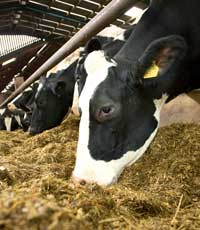Don’t rush to feed maize silage

Producers should hold off feeding maize silage until 4-6 weeks after ensiling to avoid shortfalls of energy in the ration, according to Jack Torrens, technical support for David Bright Seeds.
“When you use maize straight away, you are punishing your cows in terms of ME – less energy will be available and you will need to make up for the shortfall with cereals.
“My key message is to keep maize sealed for four weeks – this will enable it to properly degrade and allow better presentation in the rumen.”
In fact during this 4-6 week interim period, feeding good quality grass silage and cereals could be more beneficial than feeding fresh maize, he says.
“It’s also important to be aware fresh maize analysis will overestimate the ME value of the crop and supplement fresh calvers accordingly – when you don’t, fertility will be compromised.”
Gareth Anderson, consultant for FarmGate Nutrition, agrees waiting four weeks is the best way of assessing maize quality.
“We won’t sample until maize has been ensiled for this period. When producers have to feed early, we will just test for DM% and estimate ME and starch levels.
“Analysis will set you up for formulating diets for the rest of the winter, so there is no point doing a complete analysis until the crop has properly fermented – at a time when the margin for profit is so small; it is not worth the danger of over or underestimating the value of the crop.”
Every bite counts this winter, stresses Mr Torrens. “Quantity could be disappointing in many regions, but quality is generally good. Because of this it is important to know exactly what you are working with.”
And by analysing the crop at the correct time and implementing good clamp management, it may be possible to reduce ration costs, by dropping the amount of cereals in the diet.
Taking a series of core samples from the clamp will formulate a more accurate picture of maize quality, says Simon Draper, MGA agronomist.
“When just sampling by hand, it is possible to see a 7-45% variation in starch content within the clamp because you may select a sample that’s all cob or all leaf.”
Instead, producers should take ten core samples in a W shape across the top of the clamp, then mix in a bucket and take an overall sample for analysis. And when farmers are reluctant to climb on top of the clamp, taking a series of core samples from the face will create a better picture than taking a handful.
And because ambient temperatures are still warm, working across the clamp face as quickly as possible when feeding out is even more important to prevent spoilage, he says.
“When you don’t work across the clamp quick enough, silage will begin to warm up, promoting mould growth and reducing the starch content of the crop.”
Over heating is an indication of ME going up in vapour, says Mr Torrens. “Take good, clean shear grabs of silage to prevent deterioration and clear up any loose material that drops off the clamp quickly before it warms up.”
| GETTING THE MOST FROM MAIZE • If you can, wait 4-6 weeks before sampling or feeding maize – this will allow the crop to degrade properly • Analysing fresh maize will give an inaccurate picture of energy content • Taking a series of core clamp samples will give a more accurate picture of quality |
|---|
